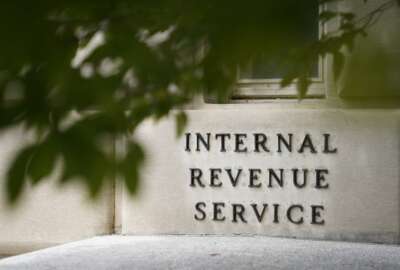

The latest spending bill from Congress is not the regular appropriations for fiscal 2023. The inflation reduction bill will allot more than $80 billion to the IRS...
Best listening experience is on Chrome, Firefox or Safari. Subscribe to Federal Drive’s daily audio interviews on Apple Podcasts or PodcastOne.
The latest spending bill from Congress is not the regular appropriations for fiscal ’23. Oh, no, no, no, no. The so called “inflation reduction bill” famously showers more than $80 billion on the IRS over 10 years. But there’s more. The Federal Drive with Tom Temin got a rundown from Bloomberg Government congressional reporter Jack Fitzpatrick.
Interview transcript:
Tom Temin: Jack, good to have you back.
Jack Fitzpatrick: Thanks for having me.
Tom Temin: And besides the IRS, other agencies are getting money here. Tell us what you’ve been able to discern?
Jack Fitzpatrick: Yeah, well, there’s a lot in this bill. Yes, the IRS is the agency that itself gets a lot of money. But there are a ton of tax credits, and that kind of thing. The energy section is very significant. So you’ve got essentially a series of green energy tax credits, renewable energy investment tax credit, there’s a nuclear tax credit, a variety of energy measures adding up to $369 billion in the energy expenditures/tax credit area, as well as electric vehicles that are tied into that. And then of course, the prescription drug measure is another significant one that’s going to direct the Department of Health and Human Services (HHS) to identify the drugs that would potentially be limited in their spending on it under Medicare. So those are kind of the three big major ones. When it comes to an agency staffing up, that’s where the IRS is the main point. And then of course, there are a lot of expenditures largely through tax credits for the energy portion.
Tom Temin: Now, will HHS get also a plus-up to staff up for this new program to look at drugs?
Jack Fitzpatrick: This does not, at least not in a significant way, appropriate a bunch of money to HHS to do that. The idea behind this prescription drug price measure is it would actually save the government money because they would be spending less through Medicare. But of course, when you do this kind of thing, that then plays into the regular appropriations process. It could stand to reason that if this gives HHS more work over the coming years, you know, 2026 is a year in which they’ve got a deadline set under this, that there could be a push to just regularly appropriate more money for their staffing to meet those needs.
Tom Temin: And any other agencies that are called out, you said energy. It’s mostly credits and so forth through the tax code. But what about grant money for research into some of these new so called greener energies and that kind of thing?
Jack Fitzpatrick: Yes, there’s some other aside from the tax code stuff. There’s offshore wind, this would allow DOE, the Department of Energy, to grant leases and rights of way for as a measure on offshore wind projects. It gives some directives to the Department of Energy for moving ahead on wind leases, that kind of thing. It’s got 4.3 billion the for the Department of Energy for the homeowner energy rebate program. So there are some expenditures, there’s a few billion dollars more going to states also that would implement high efficiency home electricity programs, dollar figures in the context of this bill that totals about $400 billion plus in spending or tax credits. It’s fairly small in terms of the grants, but there are billions in grants through DOE to kind of supplement the tax credit measures.
Tom Temin: Yeah. So there’s assignments then for a number of agencies, principally HHS, energy. And of course, as we mentioned, IRS.
Jack Fitzpatrick: Right. Yeah. Then again, that’s going to be interesting to see if there is a case made for increased regular appropriations beyond what they would potentially already want to do to enable them to meet those needs. IRS is the one that in this bill gets what they would need to plan to staff up for those directives. But then those series of directives on Department of Energy, on leasing and HHS acting on these prescription drug price measures, if they need more resources, if they need more staffing, or a change in organization that could start a conversation in appropriations.
Tom Temin: We’re speaking with Jack Fitzpatrick, he’s Capitol Hill reporter for Bloomberg Government. Speaking of regular appropriations, the continuing resolution (CR) is all been done all that pretty much signed or signed off by Congress at this point. So those appropriations pursuant to those new programmatic areas aren’t going to happen anytime in the next couple of months, then, are they?
Jack Fitzpatrick: Right. The idea of it is basically signed off on. Everybody I’ve talked to, even well before they left for August recess on appropriations said, “Yeah, we’re going to rely on a continuing resolution.” Sometime into the lame duck their goal would be to come to an agreement on government funding in the lame duck. There’s a little bit of pushback, actually from some of the conservatives. The Freedom Caucus members who are saying “Wait, if Republicans are likely to win the house, if not the Senate, why not keep that stopgap going at least into the next Congress, and then Republicans would have more votes?” So I cannot guarantee they will actually even come to an agreement in the lame duck depending on the results of the midterms. But they are certainly going to rely on a stopgap to get past September 30. They do have to negotiate some things, the energy permitting measures that Senator Joe Manchin wanted but couldn’t go through the reconciliation process. They’ve discussed attaching that to the CR. And anytime you have a must-pass piece of legislation, there’s a debate over other measures people want on there. So it’s not entirely finished, but they know they’re going to need to rely on a stopgap.
Tom Temin: Right. Joe Manchin can hope that. But he has no real leverage at this point among Democrats to do anything about permitting reform. Which again, would affect agency operations that do permitting, like the EPA and the environmental reviews, but that’s a slim likelihood at this point. Fair to say?
Jack Fitzpatrick: I’m not sure it’s a slim likelihood, because in order to help get that reconciliation bill across the finish line, Senator Schumer explicitly said, we’re going to try to put this energy permitting measure on a must-pass piece of legislation. And he specifically at one point said, the continuing resolution. I think that is an explicit enough promise so that if Schumer went back on that, it would shake a lot of people’s confidence in their ability to negotiate with him. It seems that the Democrats are moving forward on that. Now keep in mind, you do need 60 votes for a CR, you need us you need 60 votes for energy permitting measures, those permitting measures could be the kind of thing a number of Republicans like but is the well spoiled? is the well poisoned? Do Republicans want to work with Democrats on any key policy measures? Is that too risky to attach it to a CR? Do they actually end up agreeing to it? That’s I think the bigger X Factor heading toward late September, there’s pushback from Republicans who just don’t really want to help with the Democratic agenda, even if it’s a pretty bipartisan measure.
Tom Temin: And they’re all on recess until Labor Day anyway, at this point, correct?
Jack Fitzpatrick: Yes. And then when they come back, around, then, is when we typically hear about more specifics for what’s going on a CR. The anomalies debate is always interesting, because as they plan for a CR, especially if they think it could go for a while if it goes past the lame duck. There are little things here and there that lawmakers want to tweak in that CR. So the anomalies debate plus the energy permitting measure will be an interesting conversation in September.
Tom Temin: Well, meantime, enjoy the rest of the summer. Jack Fitzpatrick is congressional reporter at Bloomberg Government. Thanks so much.
Jack Fitzpatrick: Thanks for having me.
Copyright © 2025 Federal News Network. All rights reserved. This website is not intended for users located within the European Economic Area.
Tom Temin is host of the Federal Drive and has been providing insight on federal technology and management issues for more than 30 years.
Follow @tteminWFED


